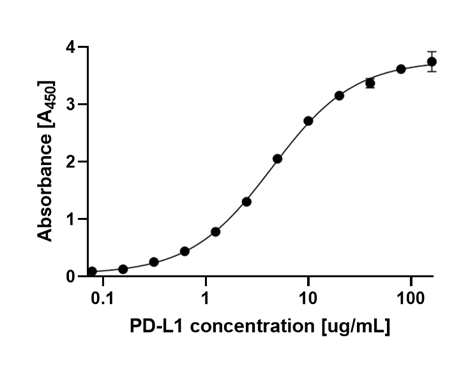Programmed cell death protein
PD-1
| Alternative names |
CD279 |
| Known ligands |
PD-L1; PD-L2 |
| Origin |
Homo sapiens |
| Accession number |
Q15116 |
| R1-001-1 |
PD-1 ECD (25-167) |
Fc-tag |
CHO |
Yes |
ELISA, WB, functional studies |
| R1-001-1a |
PD-1 ECD (25-167) |
Tag free |
CHO |
Yes |
ELISA, WB, functional studies |
| R1-001-2 |
PD-1 PD-1 ECD (25-167) |
His-tag, Fc-tag |
CHO |
Yes |
ELISA, WB, functional studies |
| R1-001-2a |
PD-1 ECD (25-167) |
His-tag |
CHO |
Yes |
ELISA, WB, functional studies |
| R1-001-3 |
PD-1 ECD (25-167) |
Tag free |
E. coli |
No |
NMR, X-Ray |
| R1-001-4 |
PD-1 ECD (34-150) |
Tag free |
E. coli |
No |
NMR, X-Ray |
ORDER NOW
Programmed cell death protein 1 (PD-1; CD279; PDCD1) is a 288 amino acid (aa) type I transmembrane protein expressed on T cells, B cells, natural killer T cells, activated monocytes, and dendritic cells (1). PD-1 belongs to the CD28 family of receptors and contains two tyrosine-based signaling motifs: a tyrosine-based inhibitory motif (ITIM) and an immunoreceptor tyrosine-based switch motif (ITSM) (2) (1). PD-1 has two known ligands, PD-L1 (B7-H1; CD274) and PD-L2 (B7-DC; CD273), members of B7 family (1) (2). Engagement of PD-1 by its ligands leads to the inhibition of T cell receptor-mediated lymphocyte proliferation and cytokine secretion which leads to exhaustion and apoptosis of tumor-specific T cells (3). Therefore PD-1 plays critical roles in the regulation of autoimmunity, tumor immunity, infectious immunity, transplantation immunity, allergy and immune privilege (4).
- Riella LV et al. Role of the PD-1 Pathway in the Immune Response. American Journal of Transplantation. 2012, 12, pp. 2575–2587.
- Chen L and Flies DB. Molecular mechanisms of T cell co-stimulation and co-inhibition. Nature Reviews Immunology. 2013, Vol. 13, 4, pp. 227-242.
- Freeman GJ et al. Engagement of the PD-1 Immunoinhibitory Receptor by a Novel B7 Family Member Leads to Negative Regulation of Lymphocyte Activation. Journal of Experimental Medicine. 2000, Vol. 192, 7, pp. 1027-1034.
- Okazaki T and Honjo T. PD-1 and PD-1 ligands: from discovery to clinical application. International Immunology. 2007, Vol. 19, 7, pp. 813–824.




